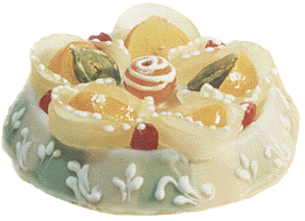...Best of Sicily presents... Best of Sicily Magazine. ... Dedicated to Sicilian art, culture, history, people, places and all things Sicilian. |
by Roberta Gangi | ||
Magazine Index Best of Sicily Arts & Culture Fashion Food & Wine History & Society About Us Travel Faqs Contact Map of Sicily |
How this occurred is a question of agriculture. The Arabs introduced sugar cane, and this revolutionised Sicilian cooking. Before the ninth century local honey was used to sweeten Sicilian pastries. Cassata is a tort of plain white cake filled with the same sheep's milk ricotta (cottage cheese) cream used in cannoli and sfinci, topped with frosting and sugared fruits. It is traditionally a winter and spring dessert served around Easter; in Sicily sheep produce little milk in summer, and frostings would melt under the torrid heat. Its name is believed to derive from the medieval Arabic kas'at in reference either to its circular form (more precisely the pan used to mold it) or the word for cheese products (cascio akin to casein). By 1300 Arab Sicily was a thing of the past, and cassata became an aristocratic dessert, its recipes jealously guarded by monastic nuns or the chefs of the aristocracy. Even today, few outside the culinary profession are ambitious enough to make it at home. Why bother, when Palermo boasts the world's greatest pastry bars? One of the earliest "modern" references to cassata was a document issued at Mazara in 1575 mentioning its importance at religious feasts. Cassata probably originated at Palermo or another city of western Sicily. Sicilian gelato (ice cream), as it has come to us, is an Arab invention based on sorbet made with cane sugar, though its earliest origins, like that of torrone, are Roman. Cassata is made year 'round but it's still best from November through April. About the Author: Roberta Gangi has written numerous articles and one book dealing with Italian cultural and culinary history, and a number of food and wine articles for Best of Sicily Magazine. | |
Top of Page |
 The culinary dictum that "simpler is better" may reflect current realities --how often do Martha Stewart or Nigella Lawson invite us to prepare complicated desserts? But some of life's tastiest treats are rather involved, and certainly time-consuming, from the standpoint of preparation. So much so that scarcely anybody chooses to make them at home anymore, deciding instead to rely on the pastry shop for this task. One of these delightfully tempting specialties is cassata, a Sicilian dessert which owes its existence to the
The culinary dictum that "simpler is better" may reflect current realities --how often do Martha Stewart or Nigella Lawson invite us to prepare complicated desserts? But some of life's tastiest treats are rather involved, and certainly time-consuming, from the standpoint of preparation. So much so that scarcely anybody chooses to make them at home anymore, deciding instead to rely on the pastry shop for this task. One of these delightfully tempting specialties is cassata, a Sicilian dessert which owes its existence to the